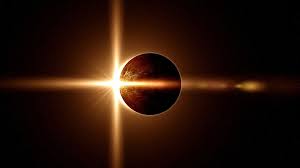Two solar and two lunar eclipses will occur in 2023, the Department of Astrophysics of the Physics Faculty of Baku State University said, SİA informs.
The first solar eclipse of next year will be recorded on April 20.
This eclipse will be a hybrid one. During a hybrid solar eclipse, due to the curvature of the Earth, an annular or total solar eclipse is observed, depending on the observer's position along the central eclipse trajectory. In most cases, hybrid eclipses begin as an annular, then transition to a total eclipse, then return to an annular state.
The eclipse event will begin at 05:34:22 am (GMT +4) on April 20 and end at 10:59:18 am. The eclipse will last 5 hours and 25 minutes. The maximum of the eclipse will be at 08:16:49 am. The total eclipse will begin at 06:36:56 am and end at 09:56:36 am. The total eclipse will last 3 hours 19 minutes 40 seconds. The eclipse will be observed in Southeast Asia, Australia, the Pacific Ocean, the Indian Ocean, and Antarctica. The eclipse will not be observed on the territory of Azerbaijan.
The second solar eclipse will occur on October 14. It will be an annular solar eclipse. When the Moon is far from the Earth, its angular size is smaller than the Sun's angular size, so it does not entirely cover the Sun's surface during an eclipse, and a bright ring appears around the Moon.
The eclipse event will begin on October 14 at 7:03:45 pm (GMT +4) and end on October 15 at 00:55:11 am. The maximum of the eclipse will be at 9:59:27 pm. The eclipse event will last 5 hours 51 minutes 26 seconds. The central eclipse event will start at 8:10:09 pm and end at 11:48:56 pm. The central eclipse process will last 3 hours 38 minutes 47 seconds. This eclipse event will be visible in West Africa, North America, South America, the Pacific Ocean, the Atlantic Ocean, and the Arctic. The eclipse will not be observed in Azerbaijan.
The first lunar eclipse of 2023 will be on May 5. It will be a penumbral lunar eclipse. The eclipse event will begin at 7:14:08 pm (GMT +4) and end at 11:31:40 pm. The maximum of the eclipse will be at 9:22:55 pm.
It will be possible to see the penumbral lunar eclipse in Southeast Europe, most of Asia, Australia, Africa, the Pacific Ocean, the Atlantic Ocean, the Indian Ocean, and Antarctica. Since the Moon will be below the horizon when the eclipse begins, the eclipse event will be observed in Azerbaijan from 7:38:00 pm. A penumbral lunar eclipse is difficult to see because the shadowed part is slightly fainter than the rest of the Moon.
The second lunar eclipse will take place on October 28. It will be a partial lunar eclipse. The penumbral eclipse will begin at 10:01:44 pm (GMT +4), and the partial eclipse will begin at 11:35:18 pm. The maximum of the eclipse will occur on October 29 at 00:14:00. The partial eclipse will end at 00:52:37 and the penumbra will end at 02:26:19 am.
It will be possible to observe the partial lunar eclipse in Europe, Asia, Australia, Africa, North America, the North-Eastern part of South America, the Pacific Ocean, the Atlantic Ocean, the Indian Ocean, the Arctic, and Antarctica. The eclipse event will also be observed in the territory of Azerbaijan.
Bütün xəbərlər Facebook səhifəmizdə































 USD
USD
 EUR
EUR
 GBP
GBP RUB
RUB
